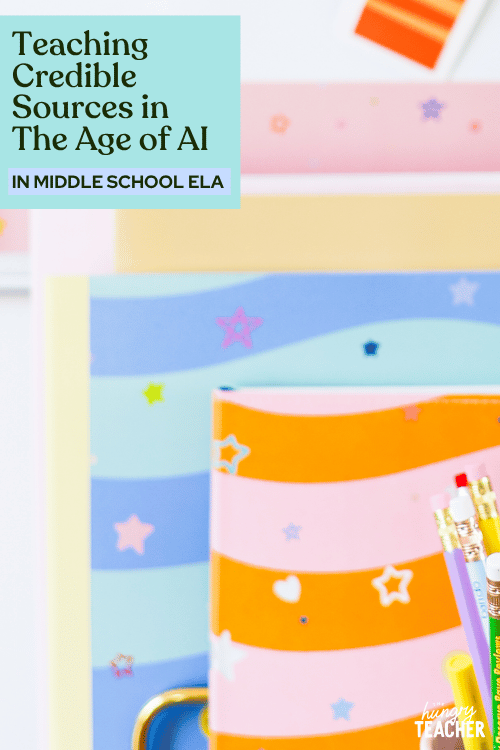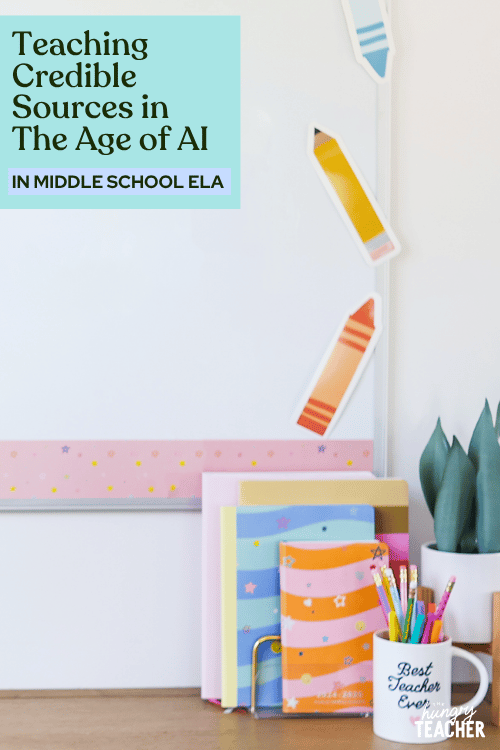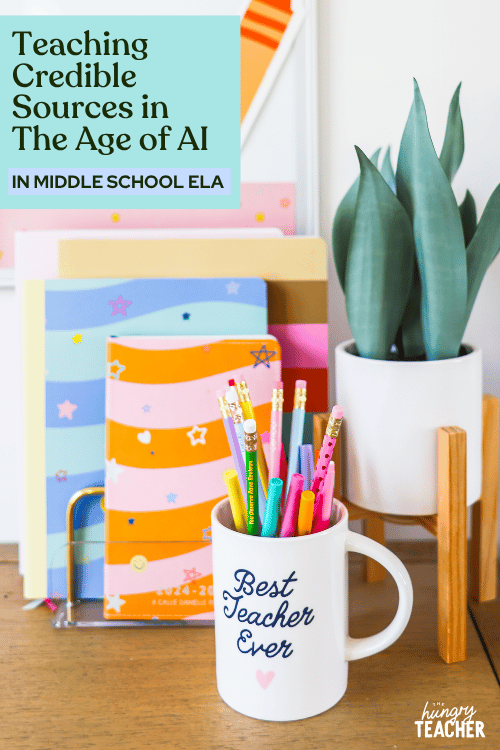hey friend!
I'm Martina.
I provide practical, time-saving strategies that actually work—so you can engage your students, teach effectively, and reclaim your time from the exhausting planning-grading cycle.
Browse Our ELA Resources
Teaching Credible Sources in the Age of AI
Like it or not, AI is a part of the classroom now. Students can easily access ChatGPT and tons of other artificial intelligence platforms with the click of a button, and it will only get more prevalent as the years go on. Generally, AI can present a lot of challenges, but one I know you’re facing in your ELA class is with research and writing. Teaching credible sources is more important than ever because misinformation (or just wrong information) runs rampant with AI.

The Problem with AI in the Classroom
When I was in the classroom, ChatGPT had yet to make its debut, but getting students to find credible sources and research was hard enough. Therefore students would Google a topic, click the first link they found, and copy and paste information. And eventually, when Google summaries started, even clicking links stopped – they’d simply copy and paste the summary information (which…wasn’t always accurate).
You face an even bigger challenge. With AI in the classroom, many students are turning to it for, well, everything. From solving math problems to writing essays, students are becoming dependent on ChatGPT for all their information, and that includes research.
The big problem? ChatGPT is pulling information from across the internet – some of it good, some of it bad. And then students often take the information it spews as fact. Plus, students aren’t the only ones using AI. Across the world, people are publishing information online that AI wrote, which means even if students research without ChatGPT, that doesn’t mean they’ll easily find credible sources of information.

Teaching Credible Sources
Moral of the story: teaching credible sources and helping students differentiate between unreliable vs. credible sources is more important than it’s ever been. Before you dive into an expository writing unit and give students full access to the internet, you’ll want to make sure you cover these basics:
(Want help teaching credible sources? Grab the Credible Sources Mini-Unit with six in-depth lessons to help students identify misinformation and write using credible sources.)
#1 Media Literacy
Before you dive into credible sources, I recommend starting with media literacy. Students need to understand just how easy it is to be “fooled” by misinformation online and the skills it takes to identify fake information.
With platforms like ChatGPT and TikTok, students have to develop media literacy. Specifically, AI can produce realistic-looking images and write articles that omit key information or get facts wrong. TikTok is also full of videos promoting false information.
Set a foundation for media literacy by showing students the lack of credible information available online. For example, you can show students a TikTok video and have them identify what information was correct. Inside the Credible Sources Mini-Unit, I include two fake articles where students must identify what is fact vs. fiction.
#2 The CRAAP Test
Now, students have to do the tough work of finding credible sources. With the CRAAP test, students will analyze six areas to determine credibility –
- Currency – Is the source up to date?
- Relevance – Is the source related to your research?
- Authority – Where is the source published? Who is the author?
- Accuracy – Is the source supported by evidence? Are the claims cited correctly?
- Purpose – What was the motive behind this source?
When students apply the CRAAP test to TikTok and ChatGPT, it’s easy to see the cracks. In this case, a TikTok video might talk about a “hazardous ingredient” in a beauty product. When students dig deeper, though, they find that the person sharing the information isn’t a scientist or doctor, they don’t share any research to support their claim, and they are promoting an affiliate link to a specific beauty brand they deem “safe”. You can do the same test on an AI article.
Inside the Credible Sources Mini-Unit, there are two lessons dedicated to teaching credible sources and then searching for credible sources online (AKA using the CRAAP test to find information).
#3 Writing with Evidence
The sources have been gathered. Now it’s time to put it into their writing. A big part of teaching credible sources is helping students understand how to cite them and include them in their writing.
I like to give my students reference pages for this because it’s a lot of material to remember. (I include these reference pages in the Credible Sources Mini-Unit.) Essentially, you want to cover –
- MLA formatting
- MLA in-text citations
- Paraphrasing vs. quoting
- Writing with evidence/sources
This is going to take practice before students get it right. I recommend hosting writing conferences to check over student progress and offer feedback along the way, as opposed to waiting until the final draft is in your hands.

Resource for Teaching Credible Sources
Want an easy-to-prep resource for navigating credible sources? Grab the Credible Sources Mini-Unit! Inside this unit, you’ll find six lessons to build a strong foundation –
- Introduction With a Fake Article to Analyze
- Practice and Learn About Credible Sources
- Practice and Use a Credible Sources Checklist
- Application
- Analysis With Two Infographic Options
- Extension With a Chance to Write a Letter
This mini-unit has everything you need, including teaching slides, daily lesson plans, printable worksheets, student reference pages, examples of each task, and more.

Want a sneak peek at teaching The Hungry Teacher way—with support, structure, and strategy?
When you join the waitlist for The Hungry Teacher’s Hub membership, you get three free classroom-ready resources: a theme unit, an expository writing unit, and a grammar unit introducing mentor sentences. Plus, you’ll get immediate access to a selection of exclusives from the Hub, including editable sub plans, pacing guides, and more.
No strings attached. Just resources you can use right now—and a heads-up when the Hub opens.
3 Free Middle School ELA Units—yours to keep!
JOIN THE WAITLIST + A FREE GIFT
Where to next, line leader?
Welcome to The Hungry Teacher! We create resources that are easy to use, practical, and get results. Teach with confidence—and make it home before dinner.
xo, the hungry teacher